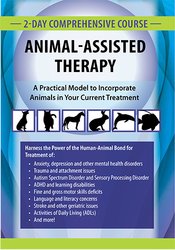

Watch this 2-day comprehensive course recording in Animal-Assisted Therapy (AAT) and learn a practical framework that facilitates incorporating evidence-based AAT into your current treatment methodology. You will receive specific, practical examples of how to implement AAT to greatly improve treatment outcomes for children, adolescents, adults, and geriatric client outcomes in a surprisingly broad range of areas, including:
You will receive resources to help you immediately implement your own AAT program, including how to select a therapy animal, tools to assess for the animal’s temperament, limitations and stress levels, and how to include AAT on a treatment plan and document it in the progress notes. Learn the latest research outcomes, solid neuroscience about the human-animal emotional bond, and information about relevant laws.
AAT improves treatment outcomes in a wide variety of fields, including mental health, speech and language pathology, occupational therapy, physical therapy, education, and medical.
| File type | File name | Number of pages | |
|---|---|---|---|
| Manual - Animal-Assisted Therapy (17.45 MB) | 106 Pages | Available after Purchase | |
| Manual - Animal-Assisted Therapy - French (17.45 MB) | 106 Pages | Available after Purchase | |
| Manual - Animal-Assisted Therapy - Italian (17.45 MB) | 106 Pages | Available after Purchase |
Jonathan Jordan, MSW, LCSW, ACSW, is a renowned licensed psychotherapist and clinical supervisor who has a love for both animals and neuroscience. For decades, he has combined these two loves by incorporating animal-assisted interventions into his brain-based professional practice. Over the years, Jonathan has trained several of his own dogs to be successful therapy animals. Not only does he integrate his therapy dogs into his own practice, Jonathan also works closely with a variety of other medical and mental health professionals to engage his therapy animals in their respective treatment modalities. He has co-developed a unique and evidence-based approach to animal-assisted intervention, the KADRA Model, which engages animals to enhance mindfulness in humans. Jonathan is a long-time member of the prestigious Society for Neuroscience and is a charter member of the Society for Social Neuroscience. Thus, he has extensive knowledge of both human and animal neuroscience research.
Jonathan is an international speaker and author on the topic of animal-assisted interventions motivating others to harness the power of the human-animal bond. He has trained thousands of professionals in his unique synthesis of East-West brain-based practices and AAT. Jonathan is currently writing a book about animal-assisted interventions that explains the incredible range of therapeutic benefits that come from the human-animal emotional bond. He serves as a faculty fellow of Florida State University and was engaged by the United States Senate to deliver brain-based professional development workshops to the entire Senate Staff on Capitol Hill in Washington, DC.
Speaker Disclosures:
PRACTICAL APPLICATION OF THE KADRA MODEL
Treatment Planning and Goals
The Legal Landscape
Please wait ...